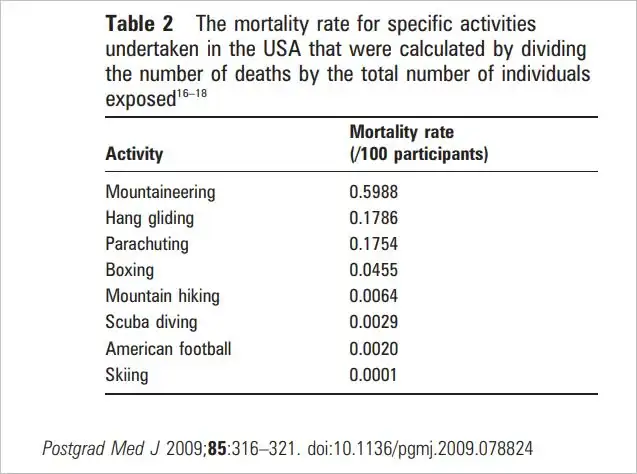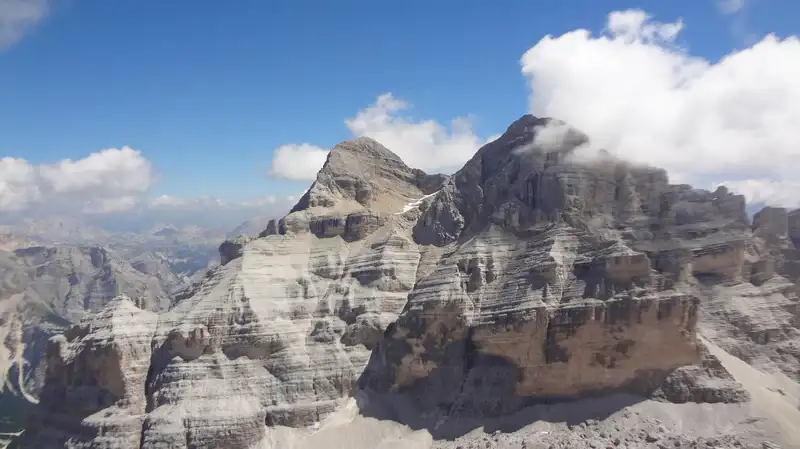The dangers of mountain climbing are in the fact that you can die, and this can be due to several different reasons that are discussed here in the text.
So, how dangerous is mountaineering? Is mountaineering really a dangerous activity?
Mountains can be deadly, and the most common causes of deaths in the mountains are the following (given in no particular order):
- Trauma.
- High altitude illness.
- Sudden cardiac death.
- Cold injury.
- Avalanches.
Mountaineering appears to be the most dangerous outdoor activity. Below I give a bit more details about this.
How mountaineering compares with some other activities
I found an article, with a table in it that summarizes it all. See how it looks:

As you see, mountaineering is by far the deadliest of all the activities listed in the table. Observe in particular how hiking and parachuting compare to it.
Trauma fatalities in the mountains
This is mainly about falls of people. As a result, you have a similar pattern of injuries. But this also includes rock falls and ice falls.
As for the ice falls, I was in the Dolomites recently when such an accident happened on Marmolada. A part of its glacier broke and killed many people below. I was on a nearby summit when this happened.
In the same article mentioned above, they write that on Denali, there is 0.308% deaths for mountaineers registered with the National Park Service. In other words, approximately one dead person on every 300 people who climb these mountains.
On Mt Rainier mortality rate is estimated to be ten times smaller, 0.031%.
High altitude illness
If you have ever climbed a mountain, then you know that already at 3000 meters or so, you can feel a big difference regarding oxygen concentration. This is a part of the total barometric pressure fall.
To deal with this, acclimatization is essential. We all react differently to altitude effects, and even reaction of a single parson can be very different in different times. I have experienced this myself on the same mountain, El Teide, which I climbed 8 times.
The illness develops as a high altitude pulmonary edema (HAPE), and as high altitude cerebral edema (HACE). If you try to gain altitude fast, you have higher chances to develop such symptoms. The higher and the faster you go, the more probable problems will be.
HAPE and HACE are responsible for the majority of deaths that occur at altitude. Note also that these two coexist. If you develop one, it is very likely you will develop the other as well. Related to this all is also what is known as paradoxical undressing.
Sudden cardiac death (SCD)
I have seen a number that this SCD accounts for up to 30% of mountain hiking fatalities. In most cases SCD is due to existing coronary artery disease.
It appears that those who undertake regular exercise are less likely to be affected with such SCDs during vigorous activities. This makes me a good candidate (to be affected) as I usually go to the mountains directly and without any regular exercises.
In a paper (Ponchia et al., J. Cardiovasc. Med. 2006, 7, 129–35) they write that in sudden cardiac deaths registered in the Tyrolean Alps in the period 1999 – 2002, around 86% did not take regular physical activity.
So now you know what to do; and I am telling this to myself as well.
Deaths due to cold injuries
Roughly speaking, you can say that temperature drops by around 6 degrees C with every 1000 meters of elevation. This may depend on several factors of course.
So if you are on 4000 meters you will be in the freezing zone year-round. If you go to the Alps you will see such mountains under glaciers. There was a tragic accident not so long ago on Pyramid Vincent in the Italian Alps when two girls froze to death.
In the case of equipment failure, or sudden weather change, you can easily find yourself in danger. The weather change was the cause in the mentioned tragedy, so they got lost and died.
Snow-avalanches
I guess we all have some idea of how this may look like. But this video will show you more:
What did Messner say about danger of mountaineering
I guess it is not necessary to make any introduction about Reinhold Messner, one of the living mountaineering legends. Here are several of his quotes regarding the danger of mountaineering:
“Mountains are dangerous places.”
“People should know before they set off that mountains, all mountains, are dangerous.”
“I go to the wild mountains where I am responsible for myself. Step by step I am making sure that I don’t die. Climbing is an adventure, not a sport.”
“I go to the mountains for an adventure and each time I pray I will get up and down again. The art of climbing is to go where you go knowing that you could die, but you don’t die. That is adventure.”
These are strong statements that need no explanations, and Messner knows mountains better than anybody. I am glad that he says that this is not a sport, this is how I see this myself.
Conclusion
So these are dangers of mountain climbing or mountaineering, regardless of how you call it. No doubt this is a dangerous activity and this for multiple reasons. You have seen some numbers above, they are descriptive enough. But one could add more to this, think about unpredictable weather conditions, mountains indeed make their own weather.
Thank you for reading. This site is all about outdoors questions and answers, and I add texts here on a regular basis, so bookmark it and keep as a reference.
You might want to check my text about nosebleeds at high altitudes and about paralpinism. Read in particular my text about situations when you fall on a ferrata tour.
Please use the comment box below in the case of questions or comments. Subscribe to my weakly newsletter and stay informed, the subscription form is given below. Have a nice day.

Leave a Reply